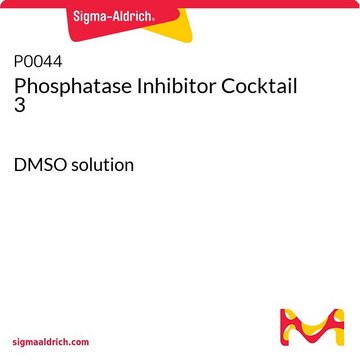524624
Phosphatase Inhibitor Cocktail I
liquid, for the inhibition of alkaline phosphatases and serine/threonine protein phosphatases
Synonym(s):
Phosphatase inhibitor
About This Item
Recommended Products
Product Name
Phosphatase Inhibitor Cocktail Set I, Phosphatase Inhibitor Cocktail Set I contains three inhibitors that will inhibit alkaline phosphatases as well as serine/threonine protein phosphatases such as PP1 and PP2A.
Quality Level
form
liquid
manufacturer/tradename
Calbiochem®
storage condition
OK to freeze
shipped in
ambient
storage temp.
−20°C
General description
Biochem/physiol Actions
Alkaline phosphatases as well as serine/threonine protein phosphatases such as PP1 and PP2A
Physical form
Reconstitution
Legal Information
Storage Class Code
10 - Combustible liquids
WGK
WGK 1
Flash Point(F)
188.6 °F - closed cup - (Dimethylsulfoxide)
Flash Point(C)
87 °C - closed cup - (Dimethylsulfoxide)
Certificates of Analysis (COA)
Search for Certificates of Analysis (COA) by entering the products Lot/Batch Number. Lot and Batch Numbers can be found on a product’s label following the words ‘Lot’ or ‘Batch’.
Already Own This Product?
Find documentation for the products that you have recently purchased in the Document Library.
Customers Also Viewed
Our team of scientists has experience in all areas of research including Life Science, Material Science, Chemical Synthesis, Chromatography, Analytical and many others.
Contact Technical Service













